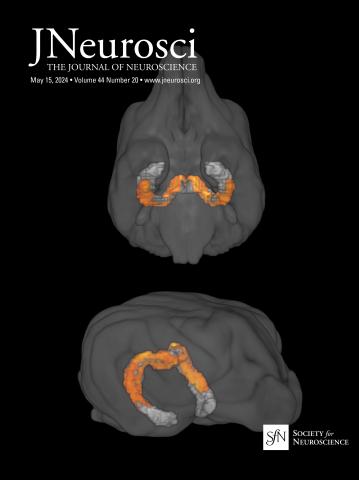灵长类伏隔核壳杏仁核和海马神经支配的专一化。
IF 4.4
2区 医学
Q1 NEUROSCIENCES
引用次数: 0
摘要
伏隔核(NAc)作为基底神经节边缘通路的主要输入结构,对目标导向行为至关重要。NAc外壳由抑制性投射神经元组成,这些神经元接受来自海马和杏仁核的强大谷氨酸神经支配。鉴于NAc的神经组成在灵长类动物中的特异性变化,目前尚不清楚其回路在灵长类动物中是如何组织的。我们使用系统到突触的方法来表征雌雄恒河猴(Macaca mulatta) NAc壳中的杏仁核和海马通路分布、神经支配模式和突触特征。通过共聚焦系统分析和电子显微镜在突触水平上评估,主要发现杏仁核和海马通路对NAc壳间神经元的支配与其种群大小不成比例。与这两种通路相关的突触特征是不同的。杏仁核的突起比海马突起更密集,钮扣更大,通常含有线粒体。海马通路具有更大的突触后密度和更频繁形成的穿孔突触,这些特征与高突触效能相关。此外,海马钮扣更频繁地形成多个突触,通常有一个投射神经元和一个中间神经元。这些与NAc壳的相互作用提示了杏仁核情感信号和海马体背景信息处理的不同机制。伏隔核(NAc)是动机行为的关键结构;它从杏仁核(与情感意义有关)和海马体(与环境有关)接收密集的通路。在NAc壳中,这两种通路都不成比例地支配着中间神经元,相对于它们的种群大小。杏仁核钮扣稍大一些,富含线粒体,与持续活动有关。海马末端形成了更大的突触,并且更多的是多突触,表明高突触效能。这些模式不同于先前描述的啮齿动物的电路模式。研究结果表明,内部情绪状态和与上下文相关的环境线索对NAc外壳中目标导向行为的潜在回路有不同的影响。本文章由计算机程序翻译,如有差异,请以英文原文为准。
Specializations in amygdalar and hippocampal innervation of the primate nucleus accumbens shell.
The Nucleus accumbens (NAc) is critical to goal-directed behaviors as the main input structure for limbic pathways to the basal ganglia. The NAc shell is composed of inhibitory projection neurons that receive robust glutamatergic innervation from both the hippocampus and amygdala. In view of primate-specific changes in the neural composition of the NAc, it is still unclear how its circuits are organized in primates. We used a system-to-synapse approach to characterize amygdalar and hippocampal pathway distribution, innervation patterns, and synaptic characteristics in the NAc shell of rhesus monkeys (Macaca mulatta) of both sexes. Key findings showed that both the amygdalar and hippocampal pathways disproportionately innervated NAc shell interneurons relative to their population sizes, assessed via confocal systems' analysis and at the synaptic level with electron microscopy. The synaptic features associated with the two pathways were distinct. The amygdalar projection was denser, with larger boutons that more often contained mitochondria than the hippocampal projection. The hippocampal pathway had larger postsynaptic densities and more frequently formed perforated synapses, which are features associated with high synaptic efficacy. In addition, hippocampal boutons more frequently formed multiple synapses, often with one projection neuron and one interneuron. These interactions with the NAc shell suggest distinct mechanisms for the processing of affective signaling from the amygdala and contextual information from the hippocampus.Significance Statement The nucleus accumbens (NAc) is a key structure for motivated behavior; it receives dense pathways from the amygdala, associated with emotional significance, and the hippocampus, associated with context. In the NAc shell, both pathways disproportionately innervated interneurons, relative to their population size. The amygdalar boutons were somewhat larger and enriched with mitochondria, associated with sustained activity. Hippocampal terminations formed larger synapses and were more often multi-synaptic, suggesting high synaptic efficacy. These patterns diverge from previously described rodent circuit patterns. The findings suggest that internal emotional state and environmental cues related to context differentially affect circuits underlying goal-directed behavior in the NAc shell.
求助全文
通过发布文献求助,成功后即可免费获取论文全文。
去求助
来源期刊

Journal of Neuroscience
医学-神经科学
CiteScore
9.30
自引率
3.80%
发文量
1164
审稿时长
12 months
期刊介绍:
JNeurosci (ISSN 0270-6474) is an official journal of the Society for Neuroscience. It is published weekly by the Society, fifty weeks a year, one volume a year. JNeurosci publishes papers on a broad range of topics of general interest to those working on the nervous system. Authors now have an Open Choice option for their published articles
 求助内容:
求助内容: 应助结果提醒方式:
应助结果提醒方式:


